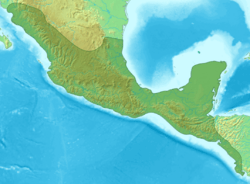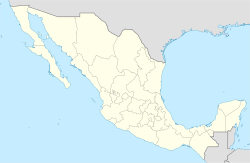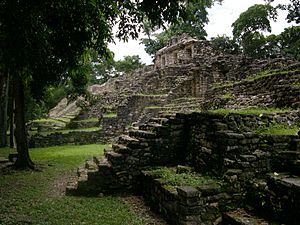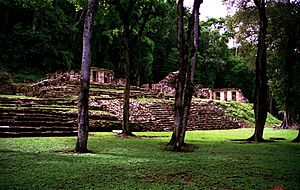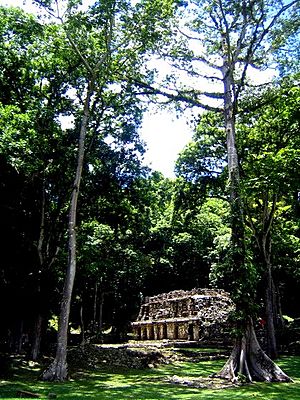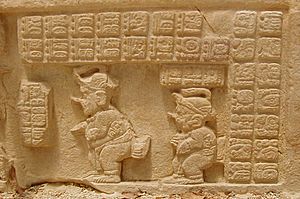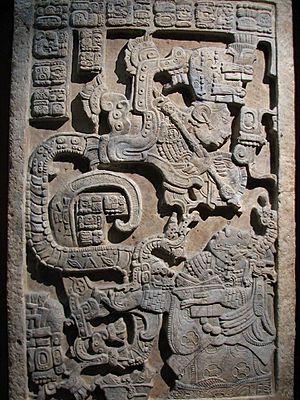Yaxchilan facts for kids
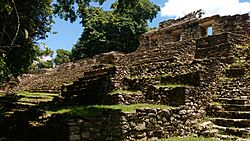
Structure 33 at Yaxchilan
|
|
| Location | Chiapas, Mexico |
|---|---|
| Coordinates | 16°54′N 90°58′W / 16.900°N 90.967°W |
| Type | Settlement |
| History | |
| Cultures | Maya civilization |
| Site notes | |
| Condition | In ruins |
Yaxchilan is an ancient Maya city located on the bank of the Usumacinta River in Chiapas, Mexico. During the Late Classic Period (around 600-900 AD), Yaxchilan was one of the most powerful Maya states along the Usumacinta River. Its main rival was Piedras Negras. The building styles in smaller towns nearby show clear differences, marking the borders between these two kingdoms.
Yaxchilan was a major city throughout the Classic era (250-900 AD). It controlled smaller sites like Bonampak. It also had a long rivalry with Piedras Negras and, for a time, with Tikal. Yaxchilan even fought with Palenque in 654 AD. The site is famous for its well-preserved stone carvings, called lintels, found above the doorways of its main buildings. These lintels, along with large stone monuments called stelae, have texts that tell the history of the city's rulers.
Contents
What Does the Name Yaxchilan Mean?
Experts who study ancient writing believe the city's old name was Pa' Chan. This name likely meant "Cleft (or broken) Sky." Early explorer Désiré Charnay called the ruins "Lorillard City." He did this to honor Pierre Lorillard IV, who helped pay for his trip into the Maya area. Later, Alfred Maudslay named it "Menché."
Teoberto Maler gave the city its modern name, Yaxchilan. This name is thought to mean "Green Stones" in a Maya language. For a while, the special symbol for the city was read as Siyaj Chan, meaning "Sky Born."
Where is Yaxchilan Located?
Yaxchilan sits on the south bank of the Usumacinta River. It is located at a bend in the river that looks like a horseshoe. This river loop protected the site on almost all sides. The only easy way to reach it was from a narrow path to the south.
The site is about 40 kilometers (25 miles) upriver from its main rival, Piedras Negras. Yaxchilan is also 21 kilometers (13 miles) from the ruins of Bonampak. The city is in the Ocosingo Municipality in the state of Chiapas, Mexico. It is on the Mexican side of the border with Guatemala, which follows the river. Another Maya site, Altar de Sacrificios, is 80 kilometers (50 miles) downriver.
The History of Yaxchilan
Yaxchilan began in the Preclassic Period (before 250 AD). Most of what we know about its history during the Classic Period comes from the carved texts. These texts were made by the kings who ruled when the city was most powerful. Hieroglyphic Stairway 1 is one of the most important of these texts. Some old writings seem to have been changed to make King Bird Jaguar IV look better. Before King Itzamnaaj B'alam II ruled (681 to 742 AD), the city was quite small. After that, it grew into a powerful regional capital. Its line of kings lasted until the early 9th century.
Early Classic Period (250-600 AD)
The known history of Yaxchilan begins with King Yopaat B'alam I. He likely became king on July 23, 359 AD. He started a long line of rulers, taking the throne when Yaxchilan was still a minor place. Carved texts from the Late Classic Period describe wars in the Early Classic. These wars were fought between Yaxchilan and its neighbors.
King K'inich Tatb'u Skull I ruled in the early 5th century. He was the first Yaxchilan ruler recorded for capturing a rival king. His prisoner was King Bird Jaguar of Bonampak. The long rivalry with Piedras Negras began in the 5th century AD. Both cities fought to control the Usumacinta River trade route. King Moon Skull was said to have won a victory over Piedras Negras in 460 AD. He also captured their king, known only as Ruler A. By the mid-5th century, Yaxchilan had connections with the great city of Tikal. Bird Jaguar II, the next king, captured a lord from Piedras Negras around 478 AD.
Knot-eye Jaguar I was a warlike king. Records show he captured nobles from Bonampak, Piedras Negras, and Tikal. In 514 AD, Knot-eye Jaguar I was captured by Ruler C of Piedras Negras. This event is shown on Lintel 12 from Piedras Negras. It shows him kneeling with his wrists tied.
His successor, K'inich Tatb'u Skull II, became king on February 11, 526 AD. This king is known for the many carved lintels he ordered. These lintels include a list of rulers that gives information about the city's early kings. K'inich Tatb'u Skull II helped Yaxchilan become powerful again. He captured lords from Bonampak, Lakamtuun, and even the lord of Calakmul. Calakmul was one of the two great Maya powers of the Classic Period. He also had success against Tikal, the other great power.
Little is known about Yaxchilan's history from 537 to 629 AD. However, four kings are known to have ruled during this time. Knot-eye Jaguar II captured the lord of Lacanha in 564 AD. This is one of the few events known from this period. The lack of detailed history might mean Yaxchilan was controlled by a stronger neighbor. These could have been Piedras Negras, Palenque, or Toniná, which were powerful in the Usumacinta region then.
Late Classic Period (600-900 AD)
The Yaxchilan paintings at Bonampak's Structure I celebrate Yaxchilan making Chan Muwaan I a ruler under their control. Yaxchilan rebuilt the site to show its connection back to Yaxchilan.
In 629 AD, Bird Jaguar III became king of Yaxchilan. In 646 or 647 AD, he captured a lord from a site called Hix Witz (meaning "Jaguar Hill"). This site was somewhere on the north side of the Usumacinta River.
Yaxchilan reached its greatest power under King Itzamnaaj B'alam II and his son Bird Jaguar IV. Itzamnaaj B'alam II died in his 90s in 742 AD. He became king in October 681 AD and ruled for over sixty years. In the last third of his rule, he started a huge building project. This included grand buildings with richly carved lintels, hieroglyphic stairways, and carved stelae. These projects changed the city center. During his rule, the kingdom of Yaxchilan grew to include nearby sites like La Pasadita and El Chicozapote. Sometimes, the sites of Lacanha and Bonampak were also under his control. However, Toniná controlled this region in 715 AD.
In 689 AD, early in his rule, Itzamnaaj B'alam II captured Aj Sak Ichiy Pat. In 713 AD, he captured Aj K'an Usja, the ajaw (lord) of B'uktunn, a site not known from other records. In 726 AD, Yaxchilan was defeated by Piedras Negras. This event is described on Piedras Negras Stela 8. A sajal (a lord under Itzamnaaj B'alam II) was captured by the enemy city. This event is not mentioned in Yaxchilan's own writings. However, it's important that Yaxchilan's texts do not falsely claim victory. After this defeat, Itzamnaaj B'alam II began his impressive building program. This might mean Yaxchilan became more independent from its powerful neighbors. It could also mean it gained more control over river trade. In 729 AD, Itzamnaaj B'alam II captured Aj Popol Chay, the lord of Lacanha. This victory, and others by Itzamnaaj B'alam II, are described in Structure 44 and on stelae near Structure 41. This victory over Lacanha is compared to Knot-eye Jaguar II's earlier win against the same city. Similarly, his capture of a lord of Hix Witz in 732 AD is compared to Bird Jaguar III's victory there.
In 749 AD, Yopaat B'alam II of Yaxchilan attended a ceremony for Itzam K'an Ahk II of Piedras Negras. If Yopaat B'alam II was king of Yaxchilan then, it suggests he was under Piedras Negras's control. This event is on Piedras Negras Panel 3. There are no records of Yopaat B'alam II's rule at Yaxchilan itself. This might mean any records were later destroyed if he did rule there.
Yaxchilan fought back in 759 AD, winning a victory over its enemy. Around 790 AD, Yaxchilan's king Shield Jaguar III oversaw the installation of Chan Muwaan II in Bonampak. He hired Yaxchilan artists to create murals in "Structure I" to remember this event.
In 808 AD, King K'inich Tatb'u Skull III recorded his capture of K'inich Yat Ahk II. This was the last king of Piedras Negras. This event likely marked the final defeat of Yaxchilan's long-time enemy. It ended the rule of kings there and destroyed Piedras Negras as a capital city.
Modern Discoveries and History
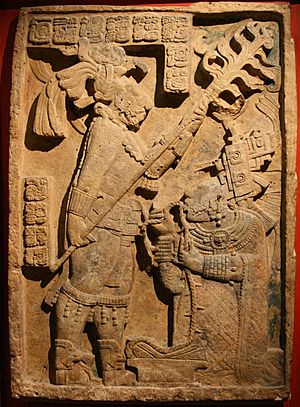
The first time Yaxchilan was mentioned in print was by Juan Galindo in 1833. This was published by the Royal Geographical Society. Professor Edwin Rockstoh from the National College of Guatemala visited in 1881 and wrote another short report.
Explorers Alfred Maudslay and Désiré Charnay arrived within days of each other in 1882. They published more detailed reports of the ruins. These included drawings and photographs. Maudslay had several lintels removed. The British Museum bought Lintel 24 in 1932. Maudslay's report was published in 1883. Teoberto Maler visited the site many times from 1897 to 1900. His detailed two-volume description of the ruins was published in 1903.
In 1931, Sylvanus Morley led a Carnegie Institution trip to Yaxchilan. He mapped the site and found more monuments.
From 1970 onwards, Ian Graham visited Yaxchilan many times. He recorded the writings there. These writings were published starting in 1977 in the Corpus of Maya Hieroglyphic Inscriptions.
The Mexican National Institute of Anthropology and History (INAH) did archaeological research at Yaxchilan in 1972-1973, again in 1983, and in the early 1990s. INAH has worked to protect and preserve the main part of the site.
Mayanist Tatiana Proskouriakoff did important work in understanding Maya writing. She used the writings from Yaxchilan to figure out the symbols for death, capture, and captor. Since then, Peter Mathews and others have continued her work.
Since 1990, a project called La Pintura Mural Prehispánica en México (Prehispanic Wall Painting in Mexico) has studied ancient murals. This project, from the Instituto de Investigaciones Estéticas of the Universidad Nacional Autónoma de México, has examined murals like those at Yaxchilan.
For a long time, Yaxchilan was hard to reach except by river. Until recently, there were no roads within 160 kilometers (100 miles). The only ways to get there were by boat for hundreds of miles, or by small plane. Since the Mexican Government built the Border Highway in the early 1980s, tourists can now visit. To reach the site, you only need to take an hour-long boat ride down the Usumacinta River from Frontera Corozal.
Some Lacandon Maya still visit Yaxchilan. They go there to perform rituals for the Maya gods.
Exploring the Ancient City of Yaxchilan
The site has impressive ruins, with palaces and temples. These buildings are around a large plaza on a terrace above the Usumacinta River. The remains of buildings spread across higher terraces and hills south of the river. They overlook both the river and the lowlands. Yaxchilan is known for its many excellent sculptures. These include large carved stelae and detailed stone carvings on lintels above temple doorways. More than 120 inscriptions have been found on the different monuments at the site.
The main areas are the Central Acropolis, the West Acropolis, and the South Acropolis. The South Acropolis is on the highest part of the site. The city's layout follows the Usumacinta River. This sometimes caused major buildings, like the two ballcourts, to be oriented in unusual ways.
Important Structures at Yaxchilan
Structure 6 is near the Main Plaza in the Central Acropolis. It is well-preserved and has six doorways. Three face the plaza, and three face the river. The doorways facing the plaza were blocked long ago. New doorways were cut into the sides of the building. The front of the building facing the plaza has a surviving carved design with a head. The structure has a remaining roof comb with holes. It is believed to be from the Early Classic Period.
Structure 7 is next to Structure 6 but is in much worse condition. Its arched ceiling has fallen. This structure also had doorways facing both the river and the Main Plaza.
Structure 8 is in the Main Plaza in front of Structure 7. It divides the plaza into two sections.
Structure 9 is an unrestored mound northwest of Structure 7. Stela 27 stands in front of it.
Structure 10 shares an L-shaped platform with Structures 13 and 74 in the Central Acropolis. This building has several carved lintels. They describe the birth and rise to power of King Bird Jaguar IV.
Structure 12 is a small building in the Central Acropolis, close to the river. It once held eight lintels from the early 6th century. The building is near one of the ballcourts. The lintels record nine generations of the city's rulers. King Bird Jaguar IV ordered these lintels to be placed in Structure 12 in the 8th century. Some of the lintels are still there.
Structure 13 sits on an L-shaped platform in the Central Acropolis, along with Structures 10 and 74.
Structure 14 is the northwest ballcourt. It is located on the Main Plaza of the Central Acropolis. Five carved ballcourt markers were found here. Three were on the playing area, and one on each side platform. One marker was removed from the site; the rest are broken.
Structure 16 is close to the northwest ballcourt. It contains Lintels 38 to 40, which have been put back in their original places.
Structure 19 is also known as the Labyrinth. It is at the western edge of the Central Acropolis. This building is a temple with rooms on three levels, connected by inside stairs. The temple front has four doorways, with three doorway-sized spaces between them. Two carved altars are in front of the building. It still has parts of a roof comb with holes.
Structure 20 is in the Central Acropolis and has three rooms. The three doorways of this building once held carved Lintels 12, 13, and 14. Only two remain now. A small part of the building's roof comb remains. The sloped roof still has carved designs with niches. Ian Graham excavated Structure 20 in 1982. During this work, a carved step was found in front of the building. It was reburied to protect it.
Structure 21 is on a terrace below Structures 25 and 26. The three lintels over the doorways in this building were Lintels 15 to 17. They were removed in the 19th century and are now in the British Museum in London. Structure 21 was excavated in 1983. The arched roof had already fallen before 1882. This filled the rooms with rubble, which has now been cleared. This uncovered important monuments, including Stela 35 and parts of life-size stucco figures on the back wall.
Structure 22 is on a terrace in the Central Acropolis near the Main Plaza. It still has carved lintels in place.
Structure 23 is in the Central Acropolis, overlooking the Main Plaza. King Itzamnaaj B'alam II built it. It is very important because it was the first major building project after 150 years of little construction. Structure 23 is dedicated to Lady K'ab'al Xook, one of the king's wives. It originally had three lintels above its doorways. These seem to mark the re-founding of Yaxchilan. This was done to strengthen King Itzamnaaj B'alam II's right to rule. Lintels 24 and 25 were removed in the late 19th century and are now in the British Museum. Lintel 26 is in the Museo Nacional de Antropología in Mexico City. These lintels are among the finest carved artworks from the Maya region.
Structure 24 is on a terrace near the Main Plaza in the Central Acropolis. It still has carved lintels in place.
Structure 25 is in the Central Acropolis, close to the path to Structure 33. It has not been excavated or restored, but some of its arched roof is still intact.
Structure 26 is next to Structure 25 in the Central Acropolis and has not been excavated. It is not as well preserved as Structure 25.
Structure 30 is in the Central Acropolis. It has three doorways facing the Plaza. The building has two parallel rooms with well-preserved arched ceilings.
Structure 33, in the Central Acropolis, is considered a masterpiece. King Bird Jaguar IV likely dedicated it in 756 AD. The building overlooks the plaza and the river. It would have been very noticeable to river traffic in the 8th century. It has plain lower walls with three doorways. Each doorway has a well-preserved lintel (Yaxchilan Lintels 1 to 3). In the center of the back wall, opposite the middle doorway, is a niche. This niche holds a headless sculpture of a human figure, probably Bird Jaguar IV. The roof of the building is mostly intact. This includes a sloped roof with a carved design and a well-preserved roof comb. There are niches in both the roof comb and the carved design. The niche in the roof comb holds parts of a sculpted figure. Pegs on both roof sections once held stucco decorations. A stairway leads up to the front of Structure 33 from the plaza. The top step of this stairway is carved and is known as Hieroglyphic Stairway 2.
The South Acropolis includes Structures 39, 40, and 41. Several stelae and altars are found with them.
Structure 39 has been restored and is in the South Acropolis. It has three stepped doorways that open into one irregularly shaped room. Parts of a roof comb with holes remain. These holes once held stucco decorations.
Structure 40 is between Structures 39 and 41. It has been restored and also has three doorways opening into one room. It has parts of a roof comb with holes. The room has remains of murals that once covered all the inside walls. Stelae 12 and 13 stand in front of Structure 40. Stela 11 once stood between them.
Structure 41 has also been restored. Like the other two buildings in the South Acropolis, it has three doorways that open into one room. It is not as well preserved as Structures 39 and 40. Much of its arched roof has fallen. A small part of a stucco frieze from the sculpture might date the building to 740 AD. This was the third K'atun anniversary of Itzamnaaj B'alam II's rule. The central doorway is stepped, and the front wall has been reinforced. It is one of three main buildings on the highest point in the city. Several stelae were placed in front of it. These stelae described the military campaigns of Itzamnaaj B'alam II.
Structure 42 is in the West Acropolis. This building had a series of carved limestone lintels. These lintels show Bird Jaguar IV's efforts to gain power. They copy events done by his father, Itzamnaaj B'alam II.
Structure 44 is in the West Acropolis. It still has a carved lintel and carved steps. Several stelae were originally found with Structure 44. Itzamnaaj B'alam II built this temple and dedicated it around 732 AD. The carved texts from this building tell the story of the city's comeback in the 8th century. Each of the three doorways had carved lintels and two hieroglyphic steps.
Structure 67 is the southeast ballcourt, located in the Central Acropolis.
Important Monuments and Carvings
Hieroglyphic Stairways
Hieroglyphic Stairway 1 leads up to Structure 5 in the Central Acropolis. It has six carved steps made of various blocks. Many of these are very worn.
Hieroglyphic Stairway 2 is the top step leading to Structure 33. It has 13 carved blocks, numbered I to XIII. Steps VI, VII, and XVIII are very well preserved. They show Bird Jaguar IV and two earlier rulers dressed as ball players.
Carved Lintels
Lintel 1 is above the eastern doorway of Structure 33 in the Central Acropolis. It shows King Bird Jaguar IV from the 8th century with his wife, Lady Great Skull Zero.
Lintel 2 is above the central doorway of Structure 33. It shows Bird Jaguar IV with his son and heir, Shield Jaguar II.
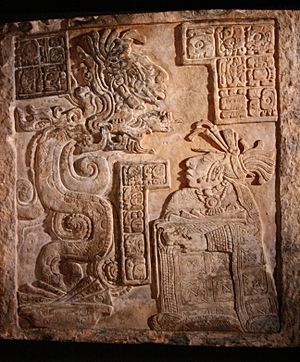
Lintel 3 is above the westernmost doorway of Structure 33. It also shows Bird Jaguar IV, this time with an ally.
Lintel 10 is the last known monument at Yaxchilan, dating to 808 AD. It shows K'inich Yat Ahk II of Piedras Negras as a captive of Yaxchilan King K'inich Tatbu Skull IV.
Lintel 12 was originally in Structure 20 in the Central Acropolis. It is now in the Museo Nacional de Antropología in Mexico City.
Lintel 13 is above a doorway in Structure 20. It had fallen when the roof collapsed but has since been put back. The carving on the lintel is very well preserved.
Lintel 14 is above a doorway in Structure 20 and is especially well preserved.
Lintel 15 originally spanned a doorway in Structure 21. It was moved to the British Museum in 1982–83. Like Lintels 16 and 17 from the same series, it was carved from limestone. It was originally above the southeast doorway of the central room. Lintel 15 shows Lady Wak Tuun, one of King Bird Jaguar IV's wives. She is performing a bloodletting ritual that causes the Vision Serpent to appear. Lady Wak Tuun carries a basket with tools for the ritual, including a stingray spine, rope, and bloodstained paper. The Vision Serpent comes out of a bowl holding strips of bark paper.
Lintel 16 also spanned a doorway in Structure 21 and was moved to the British Museum in 1982–83. It was carved from limestone and was originally above the central doorway of the central room. It shows Bird Jaguar IV holding a spear and standing over a kneeling captive. Bird Jaguar IV wears the same outfit his father is shown wearing on Lintel 26. The capture shown on Lintel 16 happened in 752 AD.
Lintel 17 was another lintel from a doorway in Structure 21 that is now in the British Museum. It is carved from limestone and was originally above the northwest doorway of the central room. It dates to the time of Bird Jaguar IV. The lintel shows Bird Jaguar IV and his wife Lady B'alam Mut performing a bloodletting ritual. The king watches as his wife pulls a rope through her tongue to draw blood. This ritual is recorded as happening eight days after the capture shown on Lintel 16.
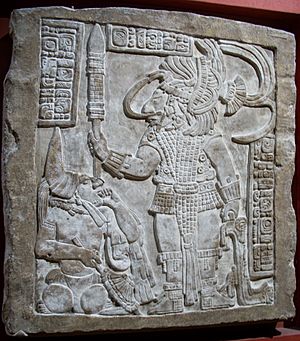
Lintel 24 is carved from limestone and is considered a masterpiece of Maya art. It is one of three lintels that were above the doorways of Structure 23. This one was above the southeast doorway. It shows a bloodletting ritual performed by King Itzamnaaj B'alam II and his wife Lady K'ab'al Xook. The king stands holding a burning torch over his wife, who pulls a spiked rope through her tongue. A folded book lies in a basket in front of the kneeling princess. The lintel has traces of red and blue paint. The ceremony shown on the sculpture happened on October 28, 709 AD. Lintel 24 was removed in the late 19th century and is now in the British Museum.
Lintel 25 was originally above the central doorway of Structure 23. King Itzamnaaj B'alam II carved it from limestone. It shows Lady Xook calling forth the Vision Serpent to celebrate her husband becoming king. Lady Xook holds a bowl with bloodletting tools: a stingray spine and bloodstained paper. The Vision Serpent rising before her has two heads. From one mouth comes a warrior, and from the other comes the head of the central Mexican god Tlaloc. Tlaloc was a water god from the distant city of Teotihuacan in the Valley of Mexico. The writing on the lintel is unusual because it is reversed, as if meant to be read in a mirror. The reason for this is unknown. Like Lintel 24, Lintel 25 was removed in the late 19th century and is now in the British Museum. The events shown on the lintel are described as happening "in front of the water of Siyan Chan." This refers to the city's main plaza being on the Usumacinta River.
Lintel 26 was the third in the series above the doorways of Structure 23. It is now in the Museo Nacional de Antropología in Mexico City. It dates to 726 AD and shows a portrait of Itzamnaaj B'alam II.
Lintel 29 is in Structure 10 in the Central Acropolis. It is part of a series of three lintels with a continuous text. This text details the birth and rise to power of King Bird Jaguar IV.
Lintel 30 is part of the lintel series carved with a continuous text in Structure 10.
Lintel 31 is another part of the series of three carved lintels in Structure 10.
Lintel 35 was found by Maudslay among the rubble of Structure 12. It is now in the British Museum. It was carved from limestone in the 6th century under King K'inich Tatb'u Skull II. It records a series of victories, including one over the great city of Calakmul.
Lintel 38, Lintel 39, and Lintel 40 have been put back in their original places in Structure 16 in the Central Acropolis. Unlike most other lintels at Yaxchilan, they are carved on their edges instead of their undersides.
Lintel 41 was above the south doorway of Structure 42 in the West Acropolis. It had fallen and broken when Maudsley found it in the late 19th century. The upper part is in the British Museum; the lower part is damaged. The lintel was carved from limestone. It is one of a series of lintels in the same building that celebrate King Bird Jaguar IV's victories. The king is shown preparing for a battle that happened in 755 AD. His wife, Lady Wak Jalam Chan Ajaw from Motul de San José in Guatemala, is offering him his spear.
Lintel 50 is in Structure 13 in the Central Acropolis.
Lintel 60 remains in its original place in Structure 12. It was found during excavations of the building in 1984.
Carved Stelae
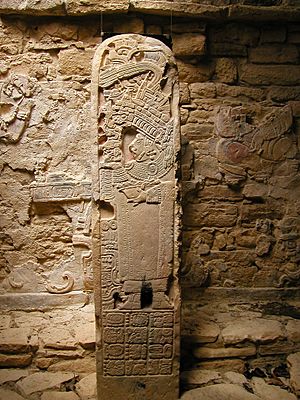
Stela 2 is on the lowest terrace opposite the stairway to Structure 33. It is very worn and dates to 613 AD.
Stela 3 stands on a platform in the middle of a plaza near Structure 20. It was badly damaged, broken into pieces. The pieces have been put back together, and the monument re-erected. One side of the stela has well-preserved carving.
Stela 5 is in front of the terrace holding Structure 20. The upper part of this monument shows King Itzamnaaj B'alam II.
Stela 6 stands in front of the terrace supporting Structure 20. It is mostly intact and shows the 7th-century ruler Bird Jaguar III.
Stela 7 was badly damaged and broken into pieces. The monument has now been put back together. The remaining carving is of excellent quality. The stela stands in front of a terrace below Structure 20. It shows a kneeling figure.
Stela 11 originally stood in front of Structure 40. The stela was removed in 1964 and shipped upriver to Agua Azul to be flown to Mexico City. It was too heavy to fly, so it was returned to Yaxchilan in 1965. It now lies near the river bank. The upper side of the stela shows King Bird Jaguar IV and his father. The figures and the carved text are very well preserved. There are various dates carved on the stela, with the earliest being 741 AD. The stela is broken into two parts.
Stela 18 dates from some time after 723 AD. It shows the victorious King Itzamnaaj B'alam II standing over a kneeling captive. The captive is identified as Aj Popol Chaj, the ruler of Lacanha.
Stela 27 has been re-erected in front of Structure 9 on the Main Plaza in the Central Acropolis. The monument dates to 514 AD and shows King Knot-eye Jaguar I. This stela is the earliest known from Yaxchilan. Stela 27 is special because it was clearly damaged long ago and later repaired in the Late Classic Period. A large part of the lower stela was reworked during the time of Bird Jaguar IV.
Stela 31 is a short distance in front of Structure 33. It is a very unusual monument because it is carved from a stalactite. It has no date and shows three carved figures and some hieroglyphs.
Stela 33 is a broken monument found during excavations of the platform supporting Stela 3.
Stela 35 is an exceptionally well-preserved monument. It was found during excavations of Structure 21 in 1983. The stela is quite small and shows Lady Eveningstar (also known as Lady Ik Skull), the mother of King Bird Jaguar IV.
Known Rulers of Yaxchilan
All dates are AD (Anno Domini).
| Name (or nickname) | Ruled |
|---|---|
| Yopaat B'alam I | 359–? |
| Itzamnaaj B'alam I ("Shield Jaguar I") | ?–? |
| Bird Jaguar I | 378–389 |
| Yax Deer-Antler Skull | 389–c.402 |
| Ruler 5 | c.402–? |
| K'inich Tatb'u Skull I | ?–? |
| Moon Skull | -454–467 |
| Bird Jaguar II | 467–? |
| Knot-eye Jaguar I | -508–c.518 |
| K'inich Tatb'u Skull II | 526–537+ |
| Knot-eye Jaguar II | c. 560–570 |
| Itzamnaaj B'alam II | ?–? |
| K'inich Tatb'u Skull III | ?–? |
| Bird Jaguar III | 629–669+ |
| Itzamnaaj B'alam II ("Shield Jaguar II") | 681–742 |
| Yopaat B'alam II | -749+ |
| Bird Jaguar IV | 752–768 |
| Itzamnaaj B'alam IV | 769–800+ |
| K'inich Tatb'u Skull IV | -808+ |
Moon Skull
Moon Skull was the seventh known ruler of Yaxchilan. He ruled in the 5th century. His name does not actually refer to the moon. Instead, it is the Maya word for a spear-thrower, a tool for throwing spears.
Bird Jaguar II
Bird Jaguar II was the eighth king in Yaxchilan's history. Two of his sons became kings after him: Knot-eye Jaguar I and K'inich Tatb'u Skull II.
Knot-eye Jaguar I
Knot-eye Jaguar I was the ninth known king of Yaxchilan. He ruled in the early 6th century. His name in hieroglyphs should probably be read as Joy B'alam. He was a son of the previous ruler, Bird Jaguar II.
K'inich Tatb'u Skull II
K'inich Tatb'u Skull II is the tenth king on the list of rulers. He was another son of Bird Jaguar II.
Bird Jaguar III
Bird Jaguar III is described in one text as the fifteenth ruler after Yopaat B'alam I. Bird Jaguar III married Lady Pakal. She lived a very long life, dying in 705 AD at the age of at least 98 years. Their son and heir was Itzamnaaj B'alam II.
Itzamnaaj B'alam II
Itzamnaaj B'alam II became king in October 681 AD and ruled for 60 years. He was often called "Master of Aj Nik" in hieroglyphic texts. This referred to his first captive before he became king. This phrase was added to his name 32 times. Aj Nik was a minor lord from a place called either Maan or Namaan.
Images for kids
See also
 In Spanish: Yaxchilán para niños
In Spanish: Yaxchilán para niños


